Sometimes Y-DNA reveals unsuspected relationships between men with different surnames and in different locations. It is only by researching all of them that we can find the answers we have been seeking.
This case is a great example. I have an ancestor named Henry Gragg who was born 1763 in South Carolina. After exhaustive research, I was no closer to finding his parents.
Y-DNA was the best option to find his father. I might even be able to extend this line several generations further.
If you are new to Y-DNA testing, please review Y-DNA STRs, SNPs, and Haplogroups. The page will open in a new window so that you don't lose your place here.
Mr. Gragg's closest STR matches appear to be a Craig and two men named Smith.
If you are new to Y-DNA testing, please review Y-DNA STRs, SNPs, and Haplogroups. The page will open in a new window so that you don't lose your place here.
First Y-DNA test
A man with the surname of Gragg took a Y-DNA test from Family Tree DNA. He is a descendant of Henry Gragg from South Carolina.
When Y-DNA results are returned, there is a list of people with similar results. Here was Gragg's list of matches at 37 markers [The given names have been erased by me to protect privacy]:
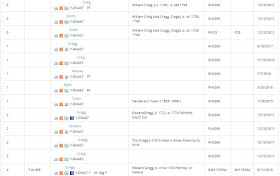 |
| 37-marker match list |
Two of the men on the match list had family trees, and they were both descendants of an ancestor Edward Gregg, born 1722. He lived in the same area of South Carolina as Henry Gragg did. Could these men be related?
Gregg family research
I have researched the Graggs in South Carolina for years. As it turns out, in this area of South Carolina there was no other Gragg, Gregg, Grigg, or other man with a variant surname except Edward Gregg.
Edward Gregg arrived in South Carolina in 1752 with his wife and four children. Although no documentation has been found of the children of Edward Gregg, it appears that Henry was his son. Y-DNA supports this supposition.
Here is the Gragg tree with Edward Gregg added as Henry's father. Note that Henry's descendant is also descended from the James Mullins discussed in a previous post, Y-DNA: Big Y test solves STRs and convergence.
Here are the family trees of the two descendants of Edward Gregg:
Craig, Gragg, and Gregg:
At 111 markers there is only one match, and he is the Gregg who has taken the Big Y-500 test. We should be able to find him on Mr. Gragg's Big Y match list.
But we also need to see why one of the Gregg descendants is a genetic distance of two and the other is a genetic distance of four from Mr. Gragg.
Joining Projects
To join a project, click myPROJECTS at the top of the screen, then select Join A Project:
You will see various categories of projects. We will look for a Gragg surname project. In the Surname Projects category, click on the letter G.
There are no Gragg or Gregg projects, but there is a Grigg surname project. Click the name of the project, then click Join on the next page.
Here is the Gragg tree with Edward Gregg added as Henry's father. Note that Henry's descendant is also descended from the James Mullins discussed in a previous post, Y-DNA: Big Y test solves STRs and convergence.
 |
| Descendant of Christopher Gragg |
Here are the family trees of the two descendants of Edward Gregg:
 |
| Descendant of John Nelson Gregg |
 |
| Descendant of Daniel Gregg |
Genetic Distance
The descendants of John Nelson Gregg and Daniel Gregg are more closely related to one another than they are to Mr. Gragg.
However, when we look at the Y-DNA match list, the first column is the Genetic Distance column.
We can see in the Genetic Distance column that one of these men is a genetic distance of two from Mr. Gragg, and the other is a genetic distance of four. These 37 marker results make it appear that one of the Greggs is more closely related to Gragg than the other man is.
There are also Craigs and possibly Smiths who appear to be related. The Genetic Distance column is not enough to determine the relationships.
How are men with these surnames related?
After seeing that Edward Gregg was a possible ancestor to Mr. Gragg there were various routes that could be taken to learn more.
One is to upgrade the results to see more STRs. Another is to upgrade to Family Tree DNA's Big Y test which includes 111 STRs and much more.
Mr. Gragg and a descendant of Edward Gregg [through Edward's great-grandson John Nelson] took the Big Y-500 test to find the most information about their relationship. The Big Y-500 test was the test available in 2018.
More STRs
Included with the Big Y test is an upgrade to 111 STRs.
At 67 markers, the two descendants of Edward Gregg are still showing the same genetic distances. This means no new mutations occurred in the 38-67 marker panel.
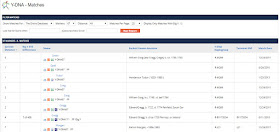 |
| 67-marker match list |
At 111 markers there is only one match, and he is the Gregg who has taken the Big Y-500 test. We should be able to find him on Mr. Gragg's Big Y match list.
 |
| 111-marker match list |
But we also need to see why one of the Gregg descendants is a genetic distance of two and the other is a genetic distance of four from Mr. Gragg.
The Y-DNA match list only shows us the total genetic distance. It does not show the details. For this we need to join surname or other projects.
Joining Projects
 |
| Join a Project |
You will see various categories of projects. We will look for a Gragg surname project. In the Surname Projects category, click on the letter G.
 |
| Family Tree DNA Project links |
There are no Gragg or Gregg projects, but there is a Grigg surname project. Click the name of the project, then click Join on the next page.
There is no charge to join a project, and you can join as many as you wish.
You will next see the Account Settings screen with several tabs. It is essential that you click on each tab. We will just look at the Project Preferences tab right now.
Edit each project by clicking the pencil icon on the right. Select the Access level you want to give the Project Administrators. In most cases "Limited" is the recommended choice.
When you have finished, see the left side of your home screen where you will see the projects you have already joined.
Click on any project name to go to its website.
Here is the Grigg surname project. Click on Colorized Chart to see the full list of STRs with the differences highlighted for each man.
Even though I clicked on Colorized, these results were found in an ungrouped section that did not have modal values. Because there are no modal values, there are no colorized differences.
The two descendants of Edward Gregg are listed immediately above the descendant of Henry Gragg. It is difficult to see the genetic distance in the above image, but here is a closeup:
The first results shown are from the descendant of Edward through John Nelson Gregg. He is a genetic distance of four from Mr. Gragg [listed third]. He is off by three alleles at DYS576 and one at DYS442.
How to make results visible in projects
The primary reasons to join projects are to compare STRs, see matches that do not appear on your match list, get advice from project administrators, and advertise your results to encourage others to do DNA testing or to upgrade their results.
Many people do not realize that your project administrator and other members of the project may not be able to see the results. This defeats the main advantages of projects. This is the most important part: Update your account settings.
Hover your mouse over your name in the upper-right of your screen. A drop-down menu will appear. Click on Account Settings:
 |
| Account Settings |
You will next see the Account Settings screen with several tabs. It is essential that you click on each tab. We will just look at the Project Preferences tab right now.
 |
| Project Preferences |
On the next screen you will see the Group Project Administrator Access. Be sure to "Opt in to Sharing" at the bottom of the screen:
 |
| Group Project Preferences |
Edit each project by clicking the pencil icon on the right. Select the Access level you want to give the Project Administrators. In most cases "Limited" is the recommended choice.
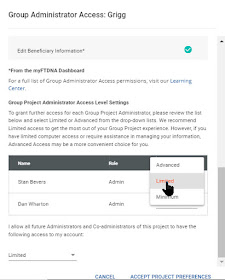 |
| Determine Project Administrator access |
When you have finished, see the left side of your home screen where you will see the projects you have already joined.
 |
| Family Tree DNA Projects |
Click on any project name to go to its website.
Surname Projects
Here is the Grigg surname project. Click on Colorized Chart to see the full list of STRs with the differences highlighted for each man.
 |
| Grigg Surname Project |
Even though I clicked on Colorized, these results were found in an ungrouped section that did not have modal values. Because there are no modal values, there are no colorized differences.
| Grigg Surname Project Results |
The two descendants of Edward Gregg are listed immediately above the descendant of Henry Gragg. It is difficult to see the genetic distance in the above image, but here is a closeup:
 |
| STR differences |
The first results shown are from the descendant of Edward through John Nelson Gregg. He is a genetic distance of four from Mr. Gragg [listed third]. He is off by three alleles at DYS576 and one at DYS442.
Because of this three-allele mutation at DYS576, he is also a genetic distance of four from his much closer cousin, listed second in the table above. The second man [the descendant of Edward through Daniel Gregg] is a genetic distance of two from Mr. Gragg: one at CDY and one at DYS442.
Mr. Gragg is also in the Craig surname project. One reason for joining multiple projects is to find more matches.
Mr. Gragg is also in the Craig surname project. One reason for joining multiple projects is to find more matches.
Here are the results from the Craig Surname Project. The first man, who is descended from Edward Gregg, has a mutation of 16 in the last column where all the rest of the men have a 19. This column is DYS576.
Because we believe that Henry Gragg and John Gregg are both sons of Edward Gregg, Edward probably had a 19 which was mutated to a 16 in the descendants of the line of John Nelson Gregg.
Now, let's look at the Big Y results.
| Craig Surname Project Results |
Evaluating Big Y Results
Now, let's look at the Big Y results.
We cannot verify that Henry was the son of Edward without examining the mutations of several Gregg-related men taking the same test. But with just the Big Y results of these two men, we can verify that Henry Gragg and Edward Gregg have a common male ancestor.
When the Gragg and Gregg Big Y tests were completed in 2018, Mr. Gragg had two unnamed variants. This means that these mutations occurred in his line, and not in the line of Mr. Gregg.
When we clicked on the matching tab, we saw the following:
There was only one match, and he was Mr. Gregg, descendant of Edward. There is no question now--these men share a common ancestor.
When the Gragg and Gregg Big Y tests were completed in 2018, Mr. Gragg had two unnamed variants. This means that these mutations occurred in his line, and not in the line of Mr. Gregg.
 |
| Unnamed Variants |
When we clicked on the matching tab, we saw the following:
 |
| Gragg Big Y Matching, 2018 |
There was only one match, and he was Mr. Gregg, descendant of Edward. There is no question now--these men share a common ancestor.
Since their ancestors Henry Gragg and John Gregg both lived in the same area, the genealogical and DNA evidence indicate that they are highly likely to both be sons of Edward Gregg.
The Non-Matching Variants column shows that they are not very distantly related. There were three variants listed: 12031913, 14331435, and 22256644. The last two appear on Mr. Gragg's list of Unnamed Variants, so this means that those mutations occurred in the line of Henry Gragg.
The mutation 12031913 occurred in the line of John Gregg (son of Edward). We can verify this by clicking the Private Variants tab, then entering the mutation 12031913 into the Position Search box.
The results will appear below the search box. It says,"Currently no results" which means that Mr. Gragg does not have this mutation.
Often you can find out more about your DNA results by uploading to other databases. Multiple databases show additional details about your DNA results. They may also have the results of men who tested at other DNA companies.
The Non-Matching Variants column shows that they are not very distantly related. There were three variants listed: 12031913, 14331435, and 22256644. The last two appear on Mr. Gragg's list of Unnamed Variants, so this means that those mutations occurred in the line of Henry Gragg.
The mutation 12031913 occurred in the line of John Gregg (son of Edward). We can verify this by clicking the Private Variants tab, then entering the mutation 12031913 into the Position Search box.
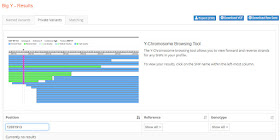 |
| Verifying unnamed variants |
The results will appear below the search box. It says,"Currently no results" which means that Mr. Gragg does not have this mutation.
Uploading to other databases
Often you can find out more about your DNA results by uploading to other databases. Multiple databases show additional details about your DNA results. They may also have the results of men who tested at other DNA companies.
The VCF file for Mr. Gragg was uploaded to The Big Tree by Alex Williamson. At that time, Gragg had no close matches. He is listed in the last column with four other men.
Mr. Gragg's results were also uploaded to YFull. Again, he had no close matches. His Most Recent Common Ancestor with these men was dated at about 3500 years ago.
Mr. Gragg needs to get more matches on the Big Tree and at YFull!
You will first notice that the screen has changed from the 2018 version. Now there is a blue link to "View Big Y Block Tree." What can be puzzling is the Non-Matching Variants.
 |
| Gragg Y-DNA results in The Big Tree at ytree.net, 2018 |
Mr. Gragg's results were also uploaded to YFull. Again, he had no close matches. His Most Recent Common Ancestor with these men was dated at about 3500 years ago.
 |
| Results in Y Tree at YFull.com, 2018 |
Mr. Gragg needs to get more matches on the Big Tree and at YFull!
A new match with a different surname
In 2019 one of the Smiths took the Big Y-700 test. This test is more comprehensive than the Big Y-500 taken by Gragg and Gregg.
Here is how Mr. Gragg's Big Y match list now appears:
 |
| Gragg Big Y Matches, 2020 |
You will first notice that the screen has changed from the 2018 version. Now there is a blue link to "View Big Y Block Tree." What can be puzzling is the Non-Matching Variants.
The STR results made it appear that Smith was more closely related to Gragg than Gregg was. However, the Big Y non-matching variants seem to indicate that he is much more distantly related. What is going on?
The variants with only numbers, such as 14332435, 22256644, and 14767685, are all unnamed. They are unnamed because they were not seen in the tests of the other men.
The variants with only numbers, such as 14332435, 22256644, and 14767685, are all unnamed. They are unnamed because they were not seen in the tests of the other men.
Like Mr. Gregg, Mr. Smith does not have the variants 14332435 and 22256644 that Mr. Gragg has. Mr. Gragg does not have the variant 14767685, but Mr. Smith does.
Why does Gragg have such a large list of Non-Matching Variants with Smith in the Big Y results? The reason for the differences is that Mr. Smith took the Big Y-700 test. This test will show variants that the previous Big Y-500 did not.
When the named variant is entered, a line will appear below the search box to show the results. The "Derived?" column is the most important one.
If the results for a position are derived, this means there is a mutation there, and it is not the ancestral value. So this column tells you whether or not a mutation was found in the test results. In this case, in the "Derived?" column the answer is Yes.
Why does Gragg have such a large list of Non-Matching Variants with Smith in the Big Y results? The reason for the differences is that Mr. Smith took the Big Y-700 test. This test will show variants that the previous Big Y-500 did not.
Big Y-500 vs. Big Y-700
Named variants start with a letter, and unnamed variants are all numerical. Therefore, the variants that start with the letters BY are all named, but they were not determined to be matches in the Big Y-500 tests of Gragg and Gregg.
Each of these variants was either not read at all in the test of Gragg or Gregg, or it were not read with enough confidence in both tests to be called a match at that time.
We can determine why some of the named variants were not called in the Big Y-500 test of Mr. Gragg by clicking the Named Variants tab, and individually entering the names of each of the named variants in the SNP Name Search box.
In the screenshot below, one of the non-matching named variants, BY28663, was entered into the SNP Name Search box.
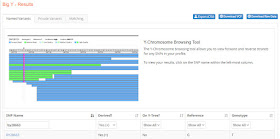 |
| SNP Name Search box in Named Variants tab |
When the named variant is entered, a line will appear below the search box to show the results. The "Derived?" column is the most important one.
If the results for a position are derived, this means there is a mutation there, and it is not the ancestral value. So this column tells you whether or not a mutation was found in the test results. In this case, in the "Derived?" column the answer is Yes.
This is baffling because this means that Mr. Gragg apparently does have this variant. If Mr. Smith also has it, why is it showing up as a Non-Matching Variant between the two men?
If we click the blue link for BY28863, we can see this variant in the Chromosome Browser.
The Chromosome Browser is showing that Mr. Gragg has a T in this position, and the Reference Sequence has a G (the ancestral value). This means that Mr. Gragg seems to have this variant.
 |
| Chromosome Browser for BY28663 |
The Chromosome Browser is showing that Mr. Gragg has a T in this position, and the Reference Sequence has a G (the ancestral value). This means that Mr. Gragg seems to have this variant.
When we look at the Chromosome Browser, however, we can see that each read is notated with the quality of that read. This position only has two high quality reads, and this was not good enough to call this SNP as a match to Mr. Gregg in the Big Y-500 results.
Although Mr. Smith has several named variants that were not called in Mr. Gragg's Big Y-500 test, the SNP name search reveals that Mr. Gragg likely does have all of these.
The best way to see the relationships between Gragg, Gregg, and Smith is to go the Big Y Matching tab and click on the link to "View Big Y Block Tree."
The Block Tree was based on Alex Williamson's Big Tree. All shared variants will be listed in the tree in the order in which they occurred. If more than one variant is shown in any block it means that the order of the variants is not yet known, and they will be listed in alphabetical/numerical order.
As you can see below, Mr. Gragg, Mr. Gregg, and Mr. Smith share a very long list of mutations that have not yet been seen in anyone else. These shared mutations are shown in the white block in the screenshot below. The unnamed "Private" variants, such as 14331435, are not listed.
The results for all three Big Y tests of Gragg, Gregg, and Smith have now been submitted to Alex Williamson's Big Tree.
Although Mr. Smith has several named variants that were not called in Mr. Gragg's Big Y-500 test, the SNP name search reveals that Mr. Gragg likely does have all of these.
The Big Y Block Tree
The best way to see the relationships between Gragg, Gregg, and Smith is to go the Big Y Matching tab and click on the link to "View Big Y Block Tree."
 |
| View Big Y Block Tree |
The Block Tree was based on Alex Williamson's Big Tree. All shared variants will be listed in the tree in the order in which they occurred. If more than one variant is shown in any block it means that the order of the variants is not yet known, and they will be listed in alphabetical/numerical order.
As you can see below, Mr. Gragg, Mr. Gregg, and Mr. Smith share a very long list of mutations that have not yet been seen in anyone else. These shared mutations are shown in the white block in the screenshot below. The unnamed "Private" variants, such as 14331435, are not listed.
 |
| Matches in Family Tree DNA Block Tree |
The results for all three Big Y tests of Gragg, Gregg, and Smith have now been submitted to Alex Williamson's Big Tree.
The results show quite a difference from the previous version where only Gragg's results were in the tree. The three of them are shown in their own branch in the fourth column from the right.
We now know from the Big Y results that Gragg, Gregg, and Smith share a common ancestor. I contacted Mr. Smith, and he told me that according to family tradition his ancestor George Smith was born out of wedlock, and that his father's name was Gragg.
 |
| Gregg, Gragg, and Smith in the Big Tree at ytree.net, 2020 |
Two of the results are now on YFull where their common ancestor is estimated at 225 years before present.
 |
| Y Tree at YFull.com, 2020 |
Finding the common ancestor
We now know from the Big Y results that Gragg, Gregg, and Smith share a common ancestor. I contacted Mr. Smith, and he told me that according to family tradition his ancestor George Smith was born out of wedlock, and that his father's name was Gragg.
I have traced his lineage, and I believe I know the name of George's father. The father lived in North Carolina. There were Craigs and Graggs in the same county, and it looks likely that George's ancestor was a Craig. He married and had sons after George was born.
We need to find a descendant of this man who will be willing to take a Y-DNA test. We may then be able to tell his relationship to Edward Gregg.
In addition to the Craig family in North Carolina who appear to be related to George Smith, there are also a large number of Craigs who are showing up as STR matches to Gragg, Gregg, and Smith. Some of these Craigs appear to be coming from the same area of North Carolina as the Craig family of George Smith.
1. Find a male descendant of the North Carolina Craig family and, possibly of the North Carolina Gragg family, and see if they are willing to take a Y-DNA test so that we can prove the parentage of George Smith.
2. Ask one of the Craigs on the list of STR matches to take a Big Y test. If the Big Y connects these men to Gragg and Gregg (as I suspect it will), there is a good possibility of tracing all these lines much further back than we now have them.
What's next?
1. Find a male descendant of the North Carolina Craig family and, possibly of the North Carolina Gragg family, and see if they are willing to take a Y-DNA test so that we can prove the parentage of George Smith.
2. Ask one of the Craigs on the list of STR matches to take a Big Y test. If the Big Y connects these men to Gragg and Gregg (as I suspect it will), there is a good possibility of tracing all these lines much further back than we now have them.
Summary
One mistake made by beginning family history researchers is ignoring variant spellings of their surname because, "My ancestor didn't spell his name that way."
In the past, there was no standardized spelling of surnames. In addition, when a large proportion of the population was illiterate no clerk asked your ancestor, "How do you spell your name?" The clerk wrote whatever he thought he heard. You may even find the clerk spelling the surname in multiple ways in the same document.
Sometimes you must be quite creative in finding records of your ancestors. For example, one census enumerator spelled the surname Jonas as Yonus because this is how he heard a German immigrant pronounce that surname. In this post we saw variant spellings of the surname Gragg, and these alternates cannot be ignored.
The ancestry of Henry Gragg can only be resolved by researching the DNA relationships and family trees of the men with the surnames Craig, Gragg, Gregg, Smith, and perhaps others. This story is not over!
We are now going to recruit some men with different variations of the surname Gregg to see what we can find.
I have made more significant breakthroughs in my family tree with Y-DNA than with any other test. We will soon be seeing several of these, all in different stages of research. It gets great.
________________________________________
________________________________________
Disclosure
Links to Family Tree DNA appear in the sidebar. I receive a small contribution if you make a purchase, but clicking through the link does not affect the price you pay.

Linda, I followed a link to this blog from the McGregor/Grier/Gregg/Gragg/etc. DNA project. I'm a McGregor descendant as well as a Smith descendant. My paternal Smith line is Welsh, and my YDNA matches include Williamson and Williams as well as Smith. Grier is also an allied surname, and I descend from a Marsh family of VA/NC that seems to have had a close connection with the family of Baptist minister Elijah Craig. I've had some correspondence with a descendant of Lawrence Smith (1797-1878) of Pyke/Lamar Co, GA who lived in very close proximity to my Smith line and who I've suspected to be a relative, but there is inconsistent YDNA. (There actually seems to be a tug-of-war within the Smith DNA project over one particular Smith line that this descendant claims.) Another descendant of this line shows up in the McGregor chart (Kit # 161903). While I'm not yet able to follow all of the technicalities of your explanation of the non-paternal event related to George Smith, I'm wondering if there might be a clue here for us both. Thank you. - Chris chris@gigs-n-digs.com
ReplyDeleteLinda, I do not know how this DNA thing works but I had my uncle take a test and I posted it to my ancestry.com account.
ReplyDeleteAccording to a distant Gragg relative I descend from William Gragg who was granted 150 acres in Newberry Co. S.C. William was with 4 other members listed as Greg on the immigrant ship Lord Dunluce that sailed from the port of Larne in Ireland in Oct. 1772 and landed in Charleston Bay in Dec. 1772. The Greg names were John, William, Ninian, Mary and Jane and they all applied for land grants on the same day in Jan. 1773. I am fairly certain this William was my fourth great grandfather. He passed in 1816 and named his children that I know were Agnes, John, William, and Thomas. supposedly there was a Mary but I'm not certain of that. I am so confused on how this William is related to the other Gregg and Gragg families. There has never been anyone else researching William who was born in 1743 and died in 1816. HIs land was sold in 1817 and it named his children. Agnes married a Williamson and is buried in Laurens County. I believe that John and William Gragg married Jane and Rebecca Gladney and no one has proven different. The Gladney family have the two women married to Greggs in S.C and I'm pretty certain they are wrong. I have searched for over 20 years to find my William Sr. and his kin in S.C. people on Ancestry have him in N.C. I really would like to solve this mystery and all the stories I have seen on different genealogy sites. If you have any input I would really appreciate it.
You can email me at Frannie5252@yahoo.com because I don't know the password to my gmail address.